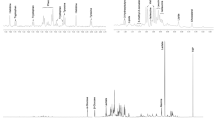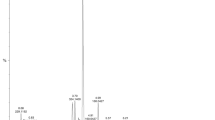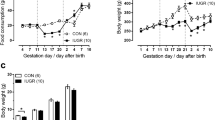Abstract
Intrauterine growth restriction (IUGR) is associated with metabolic disorders in adulthood. In rats, an early adverse environment alters food preferences in adult life. We investigated whether IUGR is associated with spontaneous macronutrient preferences in humans. Two thousand sixty-three participants from a Brazilian birth cohort were evaluated at 24 y of age using a food frequency questionnaire, physical examination, anthropometric measurements, and biochemical assays (glucose, insulin, cholesterol, and triglycerides). IUGR was defined by the birth weight ratio (BWR = birth weight/mean weight for gestational age). Individuals were classified as non growth restricted (BWR ≥0.85), moderately growth restricted (0.85 > BWR ≥ 0.75), and severely growth restricted (BWR <0.75). Severe IUGR women consumed a greater carbohydrate to protein ratio, even after controlling for social variables. There was a continuous association between growth restriction and later carbohydrate to protein ratio consumption in women. Women from both IUGR groups had a larger waist to hip ratio (WHR). The prevalence of metabolic syndrome was comparable between the groups. IUGR women preferred carbohydrates to protein in their regular diet, suggesting that spontaneous food choices may precede the appearance and contribute to the risk for metabolic diseases in this group.
Similar content being viewed by others
Log in or create a free account to read this content
Gain free access to this article, as well as selected content from this journal and more on nature.com
or
Abbreviations
- BWR:
-
birth weight ratio
References
Forsen T, Eriksson J, Tuomilehto J, Reunanen A, Osmond C, Barker D 2000 The fetal and childhood growth of persons who develop type 2 diabetes. Ann Intern Med 133: 176–182
Law CM, Shiell AW, Newsome CA, Syddall HE, Shinebourne EA, Fayers PM, Martyn CN, de Swiet M 2002 Fetal, infant, and childhood growth and adult blood pressure: a longitudinal study from birth to 22 years of age. Circulation 105: 1088–1092
Laitinen J, Pietilainen K, Wadsworth M, Sovio U, Jarvelin MR 2004 Predictors of abdominal obesity among 31-y-old men and women born in Northern Finland in 1966. Eur J Clin Nutr 58: 180–190
Barker DJ, Osmond C, Forsen TJ, Kajantie E, Eriksson JG 2005 Trajectories of growth among children who have coronary events as adults. N Engl J Med 353: 1802–1809
Singhal A, Cole TJ, Fewtrell M, Deanfield J, Lucas A 2004 Is slower early growth beneficial for long-term cardiovascular health?. Circulation 109: 1108–1113
Singhal A, Fewtrell M, Cole TJ, Lucas A 2003 Low nutrient intake and early growth for later insulin resistance in adolescents born preterm. Lancet 361: 1089–1097
Gluckman PD, Hanson MA 2004 Living with the past: evolution, development and patterns of disease. Science 305: 1773–1776
Vickers MH, Breier BH, Cutfield WS, Hofman PL, Gluckman PD 2000 Fetal origins of hyperphagia, obesity, and hypertension and postnatal amplification by hypercaloric nutrition. Am J Physiol Endocrinol Metab 279: E83–E87
Vickers MH, Breier BH, McCarthy D, Gluckman PD 2003 Sedentary behavior during postnatal life is determined by the prenatal environment and exacerbated by postnatal hypercaloric nutrition. Am J Physiol Regul Integr Comp Physiol 285: R271–R273
Bellinger L, Lilley C, Langley-Evans SC 2004 Prenatal exposure to a maternal low-protein diet programmes a preference for high-fat foods in the young adult rat. Br J Nutr 92: 513–520
Silveira PP, Portella AK, Clemente Z, Bassani E, Tabajara AS, Gamaro GD, Dantas G, Torres IL, Lucion AB, Dalmaz C 2004 Neonatal handling alters feeding behavior of adult rats. Physiol Behav 80: 739–745
Silveira PP, da Silva Benetti C, Ayres C, Pederiva FQ, Portella AK, Lucion AB, Dalmaz C 2006 Satiety assessment in neonatally handled rats. Behav Brain Res 173: 205–210
Barbieri MA, Bettiol H, Silva AA, Cardoso VC, Simões VM, Gutierrez MR, Castro JA, Vianna ES, Foss MC, Dos Santos JE, Queiroz RG 2006 Health in early adulthood: the contribution of the 1978/79 Ribeirao Preto birth cohort. Braz J Med Biol Res 39: 1041–1055
Kramer MS, Platt R, Yang H, McNamara H, Usher RH 1999 Are all growth-restricted newborns created equal(ly)?. Pediatrics 103: 599–602
Matsudo V, Matsudo S, Andrade D, Araujo T, Andrade E, de Oliveira LC, Braggion G 2002 Promotion of physical activity in a developing country: the Agita São Paulo experience. Public Health Nutr 5: 253–261
Shephard RJ, Lankenau B, Pratt M, Neiman A, Puska P, Benaziza H, Bauman A 2004 Physical activity policy development: a synopsis of the WHO/CDC Consultation, September 29 through October 2, 2002 Atlanta, Georgia. Public Health Rep 119: 346–351
Goldani MZ, Barbieri MA, Silva AA, Bettiol H 2004 Trends in prenatal care use and low birthweight in southeast Brazil. Am J Public Health 94: 1366–1371
Tomita LY, Cardoso MA 2002 Assessment of the food list and serving size of a food frequency questionnaire in an adult population. Cad Saude Publica 18: 1747–1756
Keys A, Fidanza F, Karvonen MJ, Kimura N, Taylor HL 1972 Indices of relative weight and obesity. J Chronic Dis 25: 329–343
Expert Panel on Detection, Evaluation, and Treatment of High Blood Cholesterol in Adults 2001 Executive summary of the third report of The National Cholesterol Education Program (NCEP) expert panel on detection, evaluation, and treatment of high blood cholesterol in adults (Adult Treatment Panel III). JAMA 285: 2486–2497
Olson CM, Bove CF, Miller EO 2007 Growing up poor: long-term implications for eating patterns and body weight. Appetite 49: 198–207
Riediger ND, Shooshtari S, Moghadasian MH 2007 The influence of sociodemographic factors on patterns of fruit and vegetable consumption in Canadian adolescents. J Am Diet Assoc 107: 1511–1518
Grove KL, Sekhon HS, Brogan RS, Keller JA, Smith MS, Spindel ER 2001 Chronic maternal nicotine exposure alters neuronal systems in the arcuate nucleus that regulate feeding behavior in the newborn rhesus macaque. J Clin Endocrinol Metab 86: 5420–5426
Chen H, Vlahos R, Bozinovski S, Jones J, Anderson GP, Morris MJ 2005 Effect of short-term cigarette smoke exposure on body weight, appetite and brain neuropeptide Y in mice. Neuropsychopharmacology 30: 713–719
Allen SS, Hatsukami D, Brintnell DM, Bade T 2005 Effect of nicotine replacement therapy on post-cessation weight gain and nutrient intake: a randomized controlled trial of postmenopausal female smokers. Addict Behav 30: 1273–1280
Seckl JR, Meaney MJ 2006 Glucocorticoid “programming” and PTSD risk. Ann N Y Acad Sci 1071: 351–378
Jones A, Godfrey KM, Wood P, Osmond C, Goulden P, Phillips DI 2006 Fetal growth and the adrenocortical response to psychological stress. J Clin Endocrinol Metab 91: 1868–1871
Piazza PV, Le Moal M 1997 Glucocorticoids as a biological substrate of reward: physiological and pathophysiological implications. Brain Res Brain Res Rev 25: 359–372
Dallman MF, Pecoraro N, Akana SF, La Fleur SE, Gomez F, Houshyar H, Bell ME, Bhatnagar S, Laugero KD, Manalo S 2003 Chronic stress and obesity: a new view of “comfort food.”. Proc Natl Acad Sci USA 100: 11696–11701
Epel E, Lapidus R, McEwen B, Brownell K 2001 Stress may add bite to appetite in women: a laboratory study of stress-induced cortisol and eating behavior. Psychoneuroendocrinology 26: 37–49
Ravelli AC, van Der Meulen JH, Osmond C, Barker DJ, Bleker OP 1999 Obesity at the age of 50 y in men and women exposed to famine prenatally. Am J Clin Nutr 70: 811–816
Montano MM, Wang MH, vom Saal FS 1993 Sex differences in plasma corticosterone in mouse fetuses are mediated by differential placental transport from the mother and eliminated by maternal adrenalectomy or stress. J Reprod Fertil 99: 283–290
Vickers MH, Gluckman PD, Coveny AH, Hofman PL, Cutfield WS, Gertler A, Breier BH, Harris M 2005 Neonatal leptin treatment reverses developmental programming. Endocrinology 146: 4211–4216
Shigemura N, Ohta R, Kusakabe Y, Miura H, Hino A, Koyano K, Nakashima K, Ninomiya Y 2004 Leptin modulates behavioral responses to sweet substances by influencing peripheral taste structures. Endocrinology 145: 839–847
Shultis WA, Leary SD, Ness AR, Bain CJ, Emmett PM, ALSPAC Study Team 2005 Does birth weight predict childhood diet in the Avon longitudinal study of parents and children?. J Epidemiol Community Health 59: 955–960
Klesges RC, Malott JM, Boschee PF, Weber JM 2006 The effects of parental influences on children's food intake, physical activity, and relative weight. Int J Eat Disord 5: 335–345
Cerro N, Zeunert S, Simmer KN, Daniels LA 2002 Eating behaviour of children 1.5–3.5 years born preterm: parents' perceptions. J Paediatr Child Health 38: 72–78
Silveira PP, Portella AK, Crema L, Correa M, Nieto FB, Diehl L, Lucion AB, Dalmaz C 2008 Both infantile stimulation and exposure to sweet food lead to an increased sweet food ingestion in adult life. Physiol Behav 93: 877–882
Ford ES, Giles WH 2003 A comparison of the prevalence of the metabolic syndrome using two proposed definitions. Diabetes Care 26: 575–581
Monteiro CA, Conde WL, Popkin BM 2007 Income-specific trends in obesity in Brazil: 1975–2003. Am J Public Health 97: 1808–1812
Dumesnil JG, Turgeon J, Tremblay A, Poirier P, Gilbert M, Gagnon L, St-Pierre S, Garneau C, Lemieux I, Pascot A, Bergeron J, Després JP 2001 Effect of a low-glycaemic index–low-fat–high protein diet on the atherogenic metabolic risk profile of abdominally obese men. Br J Nutr 86: 557–568
Du XL, Edelstein D, Rossetti L, Fantus IG, Goldberg H, Ziyadeh F, Wu J, Brownlee M 2000 Hyperglycemia-induced mitochondrial superoxide overproduction activates the hexosamine pathway and induces plasminogen activator inhibitor-1 expression by increasing Sp1 glycosylation. Proc Natl Acad Sci USA 97: 12222–12226
Layman DK, Boileau RA, Erickson DJ, Painter JE, Shiue H, Sather C, Christou DD 2003 A reduced ratio of dietary carbohydrate to protein improves body composition and blood lipid profiles during weight loss in adult women. J Nutr 133: 411–417
Layman DK, Shiue H, Sather C, Erickson DJ, Baum J 2003 Increased dietary protein modifies glucose and insulin homeostasis in adult women during weight loss. J Nutr 133: 405–410
Oh K, Hu FB, Cho E, Rexrode KM, Stampfer MJ, Manson JE, Liu S, Willett WC 2005 Carbohydrate intake, glycemic index, glycemic load, and dietary fiber in relation to risk of stroke in women. Am J Epidemiol 161: 161–169
Ross CE, Bird CE 1994 Sex stratification and health lifestyle: consequences for men's and women's perceived health. J Health Soc Behav 35: 161–178
Kruger J, Yore MM, Ainsworth BE, Macera CA 2008 Physical activity patterns associated with weight-control status: differences by race and sex. J Phys Act Health 5: 456–468
Reichard YK, Alricsson M, Werner S 2008 Self-related health, physical activity and musculoskeletal complaints in Swedish high school students. Minerva Pediatr 60: 263–271
Schaefer EJ, Augustin JL, Schaefer MM, Rasmussen H, Ordovas JM, Dallal GE, Dwyer JT 2000 Lack of efficacy of a food-frequency questionnaire in assessing dietary macronutrient intakes in subjects consuming diets of known composition. Am J Clin Nutr 71: 746–751
Larson NI, Neumark-Sztainer DR, Harnack LJ, Wall MM, Story MT, Eisenberg ME 2008 Fruit and vegetable intake correlates during the transition to young adulthood. Am J Prev Med 35: 33–37
Promislow JH, Gladen BC, Sandler DP 2005 Maternal recall of breastfeeding duration by elderly women. Am J Epidemiol 161: 289–296
Gillespie B, d'Arcy H, Schwartz K, Bobo JK, Foxman B 2006 Recall of age of weaning and other breastfeeding variables. Int Breastfeed J 1: 4
Apfelbacher CJ, Loerbroks A, Cairns J, Behrendt H, Ring J, Krämer U 2008 Predictors of overweight and obesity in five to seven-year-old children in Germany: results from cross-sectional studies. BMC Public Health 8: 171
Michels KB, Willett WC, Graubard BI, Vaidya RL, Cantwell MM, Sansbury LB, Forman MR 2007 A longitudinal study of infant feeding and obesity throughout life course. Int J Obes (Lond) 31: 1078–1085
Basaldúa N, Chiquete E 2008 Common predictors of excessive adiposity in children from a region with high prevalence of overweight. Ann Nutr Metab 52: 227–232
Forestell CA, Mennella JA 2007 Early determinants of fruit and vegetable acceptance. Pediatrics 120: 1247–1254
Author information
Authors and Affiliations
Corresponding author
Additional information
Supported by Fapesp, Finep, and CNPq.
Rights and permissions
About this article
Cite this article
Barbieri, M., Portella, A., Silveira, P. et al. Severe Intrauterine Growth Restriction Is Associated With Higher Spontaneous Carbohydrate Intake in Young Women. Pediatr Res 65, 215–220 (2009). https://doi.org/10.1203/PDR.0b013e31818d6850
Received:
Accepted:
Issue date:
DOI: https://doi.org/10.1203/PDR.0b013e31818d6850
This article is cited by
-
Omega-3 polygenic score protects against altered eating behavior in intrauterine growth-restricted children
Pediatric Research (2023)
-
Late-pregnancy uterine artery ligation increases susceptibility to postnatal Western diet-induced fat accumulation in adult female offspring
Scientific Reports (2020)
-
Feeding circuit development and early-life influences on future feeding behaviour
Nature Reviews Neuroscience (2018)
-
Food and nutrient intakes in young adults born preterm
Pediatric Research (2018)
-
Birth weight and catch up growth are associated with childhood impulsivity in two independent cohorts
Scientific Reports (2018)



